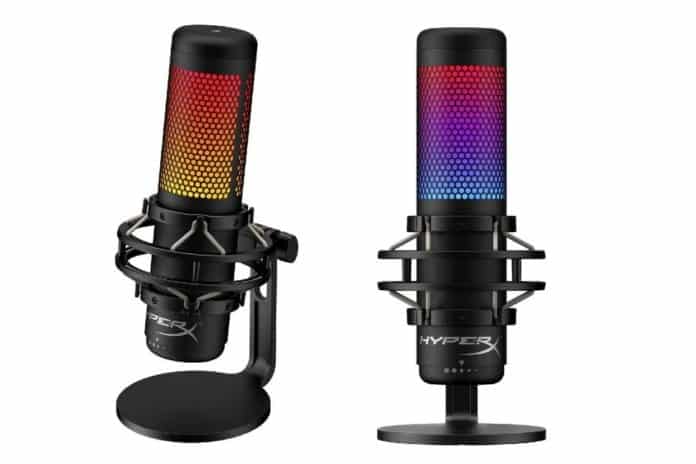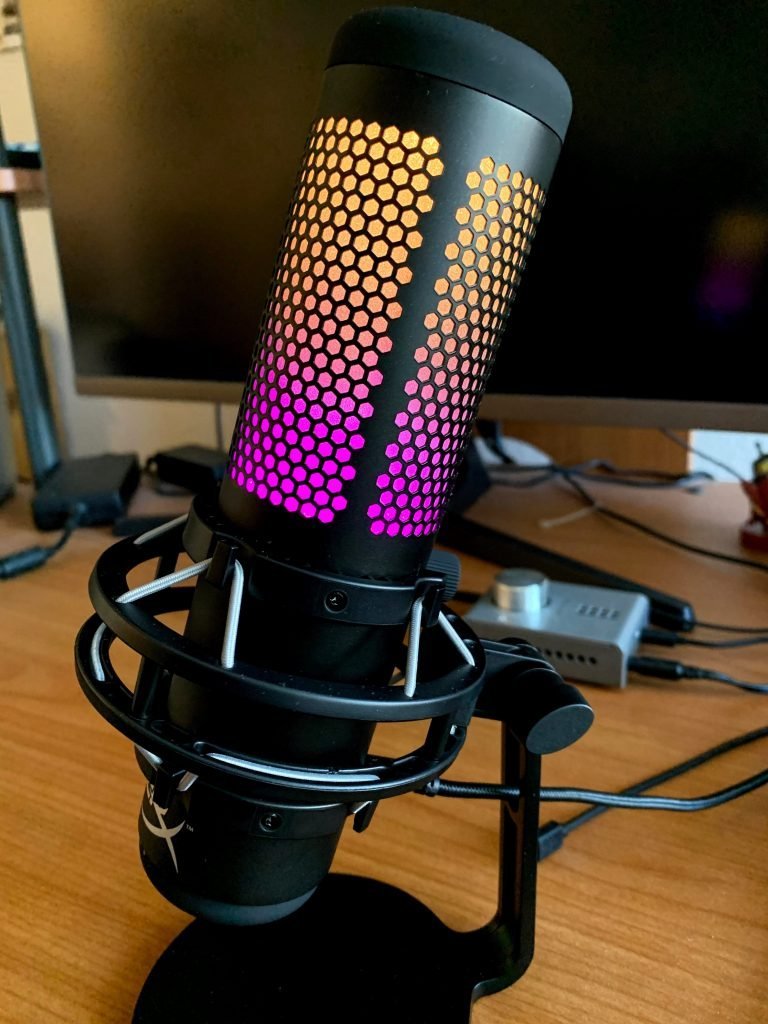
Today, we are going to deliver you with the HyperX Quadcast S review. One of our favorite microphones is back. This time it is completely colored! Here’s all about HyperX Quadcast S and its brother HyperX QuadCast Solo for solo streams.
The QuadCast S model has been completely decorated with RGB lighting, thus creating a truly attractive image. On the other hand, it has a little brother with him. This device also appears as QuadCast Solo. Now we will take a closer look at both devices and see what features they have. So, let’s start the HyperX Quadcast microphone review.
USB microphone is essential for good sound
Now, first of all, I have to say this: If you want to broadcast via video or record your comments and release them to the internet world with the Podcast, you can do this with a good gaming headset with a solid boom microphone. But if you want to do this professionally, then you have to seriously consider a USB microphone. Because the clarity and richness of sound you will get from a good USB microphone will overshadow even the best headphone boom microphone.
At this point, one option you can consider is QuadCast S. While this microphone is an essential device for broadcasters, it is also highly preferred model for podcast broadcasts. QuadCast Solo, on the other hand, has less features than QuadCast S and does not have RGB lighting.
HyperX QuadCast S Design
Let’s get to know the devices by their design in the first place. QuadCast S features soft rubber covers at the top and bottom. You can easily turn off the microphone by touching the upper edge. Thus, it is very easy to mute the microphone in your broadcasts. On the lower edge, it allows you to adjust the recording volume. You can do this very easily by turning.
When we look just below the grille at the back, we see a 4-mode wheel here. We will talk about this in more detail shortly. There are 2 connection slots on the lower edge here. Headphone and USB ports are located here.

QuadCast S already comes mounted on a stand with shock absorber. In this way, you can position the microphone on the table or hang it aside with its stand. However, for more professional use, it also includes a mounting adapter that you can attach to many microphones stands or boom arms.
QuadCast Solo is a simpler model as we said. It is smaller in size and has no lighting. You can understand it is working with the red LED on its front. You can mute it by pressing the microphone button on the top, and you can easily position it with its flexible stand. It also provides proper compatibility for the boom arm and microphone stand.
HyperX QuadCast S Features
While both devices would be ideal for streaming, there is undoubtedly more features in QuadCast S. The device, which has a built-in pop filter, helps to prevent annoying explosive sounds that interrupt your speech and there is no need for any shield filter. While the test records we have made are very clear, it should be underlined that there is no difference in terms of features compared to the predecessor model. The most crucial difference between the two devices is RGB lighting.
When we look at its features, we can see that it has a frequency response between 20 Hz and 20 kHz, and we can say that it contains 3 pieces 14 mm condenser microphones. It is sensitive to -36db and sampling at 16-bit 48Hz. In other words, when you put QuadCast S and the technical features of the QuadCast models that we have examined before, which only contain red lighting, you will not see a difference. But the result is beautiful, it’s a completely different matter.
Mode Wheel
Now let’s get to the microphone’s mode wheel. QuadCast S has a 4-way pole arrangement. Thus, you can shape the performance of the microphone according to your usage. Microphone; stereo, omnidirectional, cardioid and bidirectional. If you are going to use it alone, the cardioid mode is exactly the most logical, so the microphone focuses on the conversations made from the front. You can prefer this mostly for your individual video and podcast broadcasts.
If you are looking for a headphone, you can read our HyperX Cloud Stinger Core review: https://www.techblimp.com/2020/09/16/hyperx-cloud-stinger-core-review/
Stereo mode works well for 2 person conversations side by side. The omnidirectional mode, called omnidirectional, is a mode that you will apply in the form of a conference, especially in conversations with many people. Another mode is the two-way mode that you will use in conversations. With this feature, it is possible to get the maximum performance from the microphone.
Quadcast Solo, the small model, has a single condenser microphone and this device works only in cardioid mode. So, it is better not to expect impressive performance from Quadcast Solo in other use cases. As the name implies, it is a device designed for solo recordings.
How to Set HyperX QuadCast S RGB Lighting
Let’s also say that you can use both devices on both PC, Mac and PlayStation platforms. They follow the plug-and-play logic very easily. On the other hand, the cable length is also sufficient for the distance. Quadcast Solo has a cable length of 2 meters, while Quadcast S has a cable length of 3 meters.
HyperX QuadCast S Software
Let’s talk a little bit about Ngeunity software. While this software is still in beta, you can change the lighting of the Quadcast S through this software. While you can configure only the sound setting in the audio section, you can manage the light transitions of the microphone over 5 effects in the lights tab. However, of course, the color option is entirely up to you, you can choose color of the microphone with the color you want through the HyperX quadcast program.
You can reach HyperX QuadCast S Software from here: https://www.hyperxgaming.com/us/microphone/quadcast-gaming-microphone
By the way, the software does not support Quadcast Solo. It is not necessary since it does not have lighting anyway. This microphone directly observes the plug-and-play logic. Besides, we can say the same for Quadcast S except for the light setting.
In conclusion, we have been using Quadcast S specifically for a while. Let us say that we find it really satisfactory with the performance it provides. The previous Quadcast model was already highly successful. Features could have been enhanced in Quadcast S, but RGB support came instead which made the microphone more attractive.

No Comments!